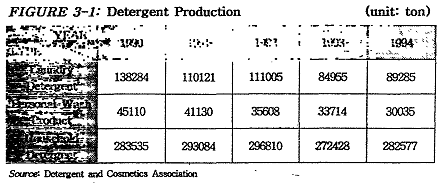
CHAPTER 3. IVESTIGATING THE MARKETING STRATEGY IN KOREAN AND FOREIGN INVESTMENT COMPANY.
3.1 Status on Korean Detergent Industry
Detergent business is grouped into three categories with each distinctive purposes: laundry detergent (e.g., fabrics cleaning and conditioning), personal wash product (e.g., skin and hair care), and household detergent. Until the 1980s, due to the nature of the laundry patterns being very uniquely traditional in comparison to the rest of the world, since most of the laundry was being hand-washed at home or in the streams, bar detergent had without any fierce competition was able to obtain a leading position in the detergent industry. But as the texture and the quality of the garments became more extravagant and sensitive and as the number of washing machine users with various ways of doing the laundry increased, demand for synthetic detergent increased at a fast pace. In the case of personal care product, several internal factors can he attributed to the rapid growth of this industry. These factors include nation's lifestyle becoming more luxuriated, bathing gaining more popularity and sanitization earning additional attention. As the nation's lifestyle moved into a new era, in another words, people becoming more aware of the changes in the environment and spending more freely, the goods they purchased had a tendency to follow the growth of the surroundings they observed. Comparing the bathing nature, which in the past, satisfaction was bestowed with just even a quick shower since conservation act was very much enforced, especially water, and also time was of great essence, but as necessities became more abundant, longer showers or baths, caring and nurturing for skin with goods that have been created to retain the healthy looking self have became part of life Concerning the sanitation aspect, fortunately, cleanliness have been emphasized for the sake of preserving the natural beauty that one self already possessed. As culture changed and became more modernized, consumer goods have diversified and segmented which allowed customers to choose from a variety of goods. Their tastes have enhanced demanding variation in products, and prices increased leaving roam for the firms to heat up the competition in trying to obtain greater market share.
Korea's synthetic detergent industry begin its epoch in J.967 with an introduction of an all-purpose laundry detergent called "Hi-Tie" manufactured by LG. Until the 1980s, "Hi-Tie" with its all purpose ingredient dominated the detergent industry for more or less 20 years. But with an increase in nation's income and 9% increase in the popularization of the washing machine each year, called for diversification in products. In 1983, new formulation of detergent which contains enzyme came into existence and 1989 thereafter, was a movement to improve the quality on the existing products. In 1991, highly condensed compacted detergent such as LG's "Han-Spoon," Ae-Kyung's 'Ultra-Park," and Jae-Il Jae-Dong's "Beat" were invented which substituted the already existing products in the detergent market. As shown in Figure 3-1 the production of synthetic (laundry) detergent. household detergent have amounted to 282,577 ton, an increase of l% from last year. And referring to the usage of the household detergent, it also shows 1% increase. Looking at the sales performance data indicated in Figure 3-2 the performance of the synthetic (laundry) detergent, personal wash and household detergent in the domestic market, although minute, they all have decreased by 1.1%, 1% and 1.2% respectively, in comparison to last year.


In examining the future prospects of the Korea's detergent industry, it is rightful to anticipate the popularization of the washing machines hence increasing the demand of the detergent. In contrast, as the demand steadily increases, the environmental issues especially the water pollution, will continue to be on a high rise. Therefore, companies need to take into considerations and be sensitive to such matters and manufacture products that assists in resolving this problem. Another assumption that can be made by observing the detergent industry is an increase in preference to of the foreign personal wash goods. Koreans by nature very much favor foreign products and as the trade barrier diminishes more opportunity will be alloted to the foreign companies and therefore, Koreans will be seeing a lot more foreign goods. With their uniquely designed marketing strategies, they will soon win the hearts of those who prize foreign goods.
3.2. Background: Unilever and LG
3.2.1 Background on Unilever
Unilever's international organization began to take shape from the day William Lever established an export business. By nature, William Lever was very detailed-oriented, hands-on manager who kept close tabs on all aspects of his business despite the growing number of the overseas companies. Over the year, concern had grown within the organization about Lever's centralized and highly personal management style. After his death in 1925, several important changes concerning worldwide operations were made. The Overseas Committee (OSC) was established to assume responsibility for managing the company's overseas businesses. The first chairman of the overseas committee, H.R. Greenhalgh, felt strongly that overseas managers should be given local autonomy. According to Greenhalgh, the role of the OSC was to provide guidance, to approve the annual estimates of sales and profits, and to monitor the regular flow of financial data and correspondence from the field. Steadily, once a very strongly centralized system restructured and moved toward decentralization of responsibility and the power of the management. Management built around independent operating companies whose managers were given maximum responsibility and freedom Local managers were given the authority to develop and implement strategies that reflected the opportunities and constraints of their particular environment. Table 3-1 (past) and 3-2 (present) show the changes in the organizational structure from centralized to decentralized.
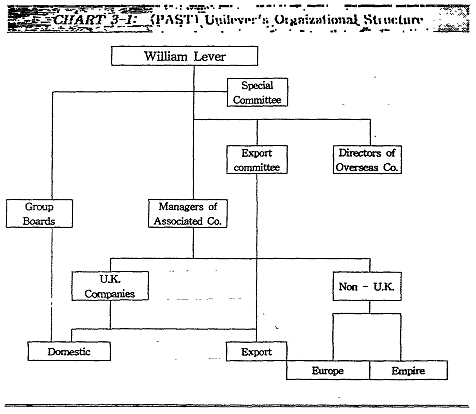
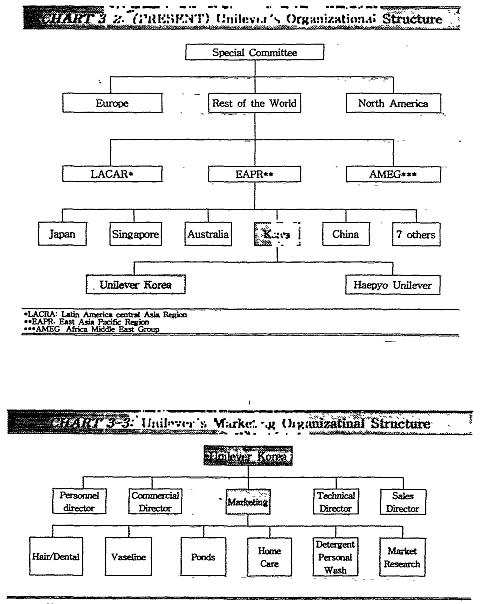
Unilever first came into existence by joining the forces with one of the most predominate consumer goods manufacturer in Korea, Aekyung Ltd.. Since it took a daring step into the land of the unknown, Unilever has experienced many vicissitudes, from a marriage with Aekyung which ended in a divorce to an endless court battles. But through all the ordeals, Unilever was able to come out of those endeavors with a positive and a learning attitude and went on to use that experience to improve their status here in Korea. Since the divorce, Unilever established a wholly-owned company called Unilever Korea and also joint ventured with Haepyo to establish Haepyo Unilever. Table 3-1 summarizes the history of Unilever Korea.

In order to achieve a long term business mission, a firm whether it be in the consumer goods or chemical 'business, need to establish some very challenging short-term objectives and Unilever is of no exception. It has created four following objectives:
① "We need to achieve an early break-even trading result on our current category portfolio and a reasonable trading margin by at least year 2000."
② "We need to achieve market dominance for skin, hair, personal wash, home care and new food segments."
③ "We need to maintain our leading position in edible oils and achieve market leadership in sesame oil and existing Korean food products."
④ "We need to become a Korean-managed international business, by reducing our independence on expatriate managers, and progressively developing our Korean managers through international exposure and experience."
3.2.2 Background: LG
Manufacturing cosmetics from its chemical business gave LG the driving force to enter the consumer goods industry. Since its first step into the industry, LG has been able to maintain their predominant position in the consumer goods market with obtaining close to 45% market share in that industry. LG participates in variety of businesses in addition to the consumer goods business. Consumer goods sales occupy 10% of the company's entire sales. Chart 3-4 describes LG's Organizational Structure. And Table 3-2 summarizes the 50 years history of LG.
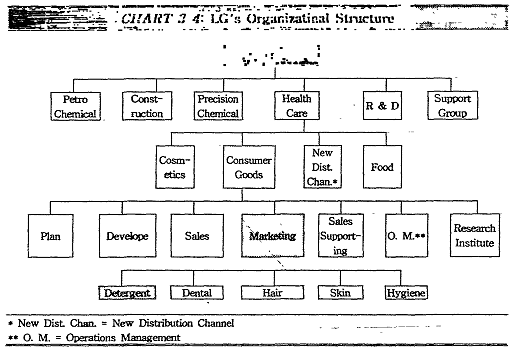
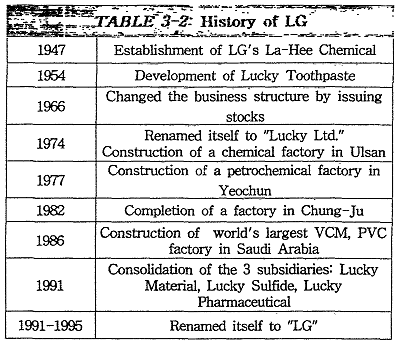
3.3 Advertising Strategy: Unilever and LG
For an advertising director of an international &m, the issue concerning whether to standardize or customize the advertisements come as a big dilemma. According to many of the proponents of the standardization, the world is moving toward homogeneity in which people, no matter where they live, will desire the same products and lifestyles. This notion most likely will apply to the similar culture where people are satisfied and dissatisfied over the same issues at hand. According to the data gathered from the in-depth interview, it vas clearly evident that Unilever practices the localization approach with decision power given to the local subsidiary. Unilever is the largest detergent manufacturer in the world. And it does not implement the same advertisements worldwide since it takes into consideration of all the differences that exists which cannot be ignored, if overlooked, which happens quite often, can allot negative reactions hence create opportunities for an attack. Unilever was able to recognize the fact that, Korea compare to the other countries, there exist substantial amount of differences in consumer tastes, preferences, and practicism which leaves very little room for the standardization approach. How was this easily detected other than through the interview? By using the decision making framework for advertising standardization established by Onkvisit and Shaw. According to Onkvisit and Shaw, a market should be segmented (localized) when following requirements are met. And in the case of Unilever, answers to all of the following questions stated "yes," therefore, it used localized marketing approach as far as the advertising events, theme, appeal, audience and budget were concerned. To reiterate the questions, they are as follow:
① Does the target group have unique and measurable characteristics?
② Can this group be reached through the available media with minimum waste?
③ Will this group respond differently but more favorably than other groups to this particular marketing mix?
④ Is the group significant enough in terms of size of justify a special attention?
⑤ Will extra costs associated with the special attention to the group be less than incremental profit?
In addition to the questions above, Likert's 7-point scale conducted shows a movement toward the customized practice.
The most impressive finding that came about through this case study was that Unilever's overall marketing strategy is based on the brand management rather than a corporate management strategy which utilized by LG. LG's strategy to accentuate the coporate name stresses a point that they are marketing the products with their name on the line which signifies that the goods are guaranteed. But for Unilever, more often than not, consumers do not realized that they are purchasing Unilevers' products. By not recapitulating the corporate name on advertisements, it can be assumed that they are in fact confident and presumputous about the products they offer to the public. It is also safe to presuppose that not emphasizing the corporate name unveils the quality of their product.
For both LG and Unilever, the get audience changes according to the product. In general, personal wash products are targeted toward the audience between the ages of 20-30 and laundry and household detergents are directed toward housewives between the ages of 25-45. LG spends close to 80% of its advertising budget on TV, 15% on women's monthly magazines, and 5% allocated between radio, newspaper, and out-door advertising media. For Unilever, advertisements are commonly allocated between TV and women's magazine. TV, occupying 90% of the budget assigned and women's monthly magazine taking up rest of the cost. Although the media allocation demonstrate considerable amount of similarities, the illustration and the appeal differ significantly. Unilever aims at trying to represent the exact nature of the product and its usage while LG directs at trying to publicize what equates to guaranteeing the products they offer since their corporate name is on a risk whenever a product is being promoted.
As the firms become more aware of the cultural differences that exist around the world, the two approaches that have been the talk among the international marketers will no longer need to push and pull to justify ones' ways since neither localization nor standardization will provide a perfect solution. The key issue on hand now is to determine when and where a limited measure of homogeneity exist for some level of customization and standardization.
3.4 Distribution Channel Strategy: Unilever and LG
Distribution channel seem to be a very sensitive and a confidential issue among the marketing managers of both of the firms. Information that was gathered through the in-depth interview was very limited. As well with channel management issue, Likert's 7-point scale was utilized. As the literature review overviews, longer channel indicates that a larger number of firms are involved in the distribution function, and the shorter channels suggest some degree of vertical integration and the presence of large scale intermediaries, most likely wholesalers. In the case of both LG and Unilever, the channel of distribution is considerably short and similar. The distribution channel structure of LG and Unilever is shown in Chart 3-6.
Also supported by the literature review and through the case study of LG and Unilever is the key elements in decision as to a distribution system They consider the following factors as of importance in selecting a distribution partner.
① The availability of middlemen
② The ability and effectiveness of the alternatives in performing the necessary function.
③ The cost of their service.
④ The extent of control that the multinational enterprise can exert over the middlemen activities.
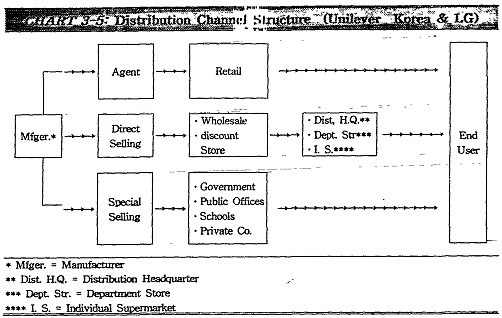
According to the marketing directors, occasionally, conflicts do arise with the channel intermediaries, but they believe international distribution necessitates compromise. The compromise involves the loss of control over foreign marketing operations in exchange for relatively low-cost representation. An advantage of using intermediaries is that they provide local market knowledge and contacts. As in the case of Unilever, after the divorce with Aekyung, it Joint ventured with Haepyo, calling it the "Haepyo-Unilever." Unilever Korea, a wholly-owned operation utilizes the Haepyo's already existing channel members. Therefore, the matter of trust, capability, and efficiency were not on the list of their priorities in selecting partners among them.
3.5 Decision Making Process Unilever
Unilever had a long history of building strong national companies that were sensitive to local need and opportunities, then allowing them the freedom to manage their local businesses entrepreneurally with minimum direction from the headquarters. As a result, Unilever built and maintained a dominant worldwide business. Shown in Chart 3-7 and Chart 3-8 state the level of decision making power along with the degree of standardization/localization on each issues (advertising and distribution channel) at hand are dealt with in Unilever Korea.

The company decided to manage its detergent products' H 8z D in a more centralized fashion while leaving the marketing function more decentralized emerged as a general solution that gradually modified to clarify responsibilities on a task basis. As can be seen in Charts 3-7 and 3-8, in the detergents marketing, advertising strategy were delegated but coordinated from the center, and distribution tasks were kept largely local since localites will be able to provide local market knowledge and contects.
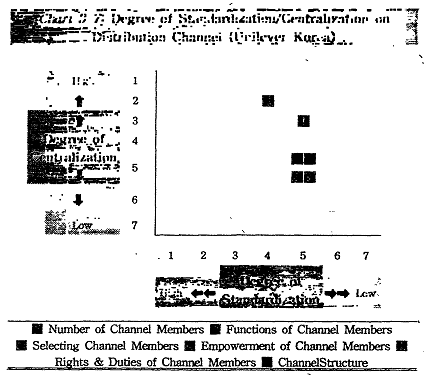
Chart 3-9 shows graphically the varying needs for global needs for global integration and national differentiation in Unilever's business strategies, functional responsibilities and tasks.
